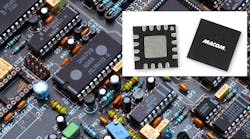Switch drivers are often overlooked among the circuitry in high-speed, high-frequency circuit boards. However, they are essential components for controlling the operation of semiconductor devices, such as PIN diodes. In terms of speed, repeatability, and reliability, RF/microwave signal switching depends on durable switch drivers such as the models MADR-011020 and MADR-011022 from MACOM Technology Solutions Inc.
Optimized for use with the company’s AlGaAs and HMIC PIN diode switches, these negative-voltage drivers enable extremely fast switching speeds but with very simple component layouts for low-cost switching solutions in both commercial and military applications. The two driver models support medium- and low-power switching circuits with almost negligible propagation delays and minimal quiescent current.
Each switch driver model is supplied in a 4- × 4-mm, 16-contact, power quad flat no-lead (PQFN) package (see figure) to save space in a circuit with a single-pole, double-throw (SPDT) switch. Model MADR-011020 is designed for medium-power applications, providing back-bias voltage selection from −20 to −50 V dc. Also, as much as 50 mA of sinking and sourcing bias current is available for SPDT PIN diode switches or integrated-circuit (IC) PIN diode switches fabricated with the firm’s heterolithic-microwave-integrated-circuit (HMIC) process.
A pair of negative-voltage switch drivers provide fast switching speeds for a line of SPDT AlGaAs HMIC PIN diode switches.
The switching speed of the MADR-011020 driver and its associated switch (propagation delays) is less than 60 ns when driving a 10-pF capacitive load. The switching speed is considered as the “on” time from 50% of the control signal to 90% of the control voltage, or the “off” time from 50% of the control signal to 10% of the control voltage.
The model MADR-011022 switch driver provides back voltages from −10 to −25 V dc with as much as 25 mA sinking current and 20 mA sourcing current for lower-power SPDT AlGaAs PIN diode and HMIC switches. Both switch drivers have built-in power sequencers to eliminate the need for external power sequencers (and simpler circuit layouts). The internal power sequencers can be operated with standard transistor-transistor-logic (TTL) programmable control. The switching speed of the MADR-011022 switch driver and its associated PIN diode switch is less than 80 ns from an “on” or “off” control signal to 90% or 10%, respectively, of the control voltage.
Single switch drivers are designed for use with the firm’s line of HMIC SPDT PIN diode switches, with complementary output ports that provide as much as 25 mA sinking current and 20 mA sourcing bias current to the switches. For added flexibility, the drivers have an extra control pin so that two drivers can work together in parallel to operate higher-order switch configurations, such as single-pole, three-throw (SP3T) and single-pole, four-throw (SP4T) switches. Compatible AlGaAs HMIC PIN diode switches are available for frequencies through 26 GHz.
In companion with the firm’s line of AlGaAs HMIC PIN diode switches, these packaged driver devices are very energy-efficient for use with many different power supplies. The enable pins on each switch driver can be employed to realize a simple, “all-off” switching state with associated switches. The switch drivers contribute very little energy waste in 50-Ω circuits, with less than 1 mA quiescent current under typical operating conditions. The lead-free, RoHS-compliant switch drivers are designed for operating temperatures from −40 to +85°C and are suitable for commercial and military applications.
MACOM Technology Solutions Inc., 100 Chelmsford St., Lowell, MA 01851; (800) 366-2266, (978) 656-2500, FAX: (978) 656-2804.


